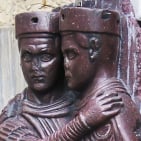Low diacritics

mauro sacchetto
Posts: 353
What logic should be followed when positioning diacritics such as Low Modifiers, for example Modifier Letter Low Vertical Line (uni02CC) or Modifier Letter Low Macron (uni02CD) and also Combinig Below diacritics, for example Combining Vertical Line Below (uni0329)?
In fact, I note that in some fonts that I am analyzing, they are aligned neither to the same base line at the bottom nor to the same line at the top, but placed at different heights whose logic I do not understand. Thank you!
0
Comments
-
1. Modifiers are not diacritics. They are glyphs per si and are not combined with other glyphs. So you create then as 'normal' spaced letters. Most modifiers are used in phonetics, what makes vertical spacing much lower than the one for diacritics.
A sample (by the way, the up tack is somewhat anemic, I need to fix it) :
2. Overall criterion is to use the same vertical space for diacritics above and below. You will find variations both due to bad design and to optical adjust. I use baselines for diacritics above and below with the same distance from base letters, but sometimes do optical adjusts in diacritics to achieve a consistent view.
An example: in the image below, macron and dot accent would be very low if landed at the same base position of acute or circumflex, so they were raised a bit.
And a sample of diacritics below base letters. Note that y is a special case:
0 -
Thank you! So you adopt for the mst part of the glyphs the same line, but insert changes (for example for the low macron) of the adjustments based on the purely visual aspect; quite right?1
-
Indeed, the spacing of modifier letter should vary depending on the shape of the glyph.For the height, you can either have the ones above, just above the x-height or closer to the ascender height, for the ones below, just below the baseline or closer to the descender height.Note that the low macron was used in the International Phonetic Alphabet from the 1920s until 1989 when it became obsolete, it was an alternative to the macron below indicating low tone. Tone bars or the grave accent are used instead since 1989.See for example the Thai sample in the 1949 Principles of the International Phonetic Association:

0 -
but then there are insurmountable problems, if the location of the glyphs varies according to the languages ... in the example that shows some long signs are placed next to the words; in Latin or Greek instead they are placed above the vowels
0 -
in the example that shows some long signs are placed next to the words; in Latin or Greek instead they are placed above the vowels
The lines in the example from the 1949 book are not 'long signs'; they're syllabic tone markers. These would be encoded as spacing modifiers, which are different characters from the combining macron mark.0 -
A last question. Typically the same diacritic is the same for upper and lower case. I note, however, that some fonts (for example Pardo's EB Garamond 12) have, among other things, how as low macron a shorter glyph for lower case and a longer one for upper case. Is it good practice or is it a bizarre solution?0
-
It's often the case that uppercase diacritics have different forms for above marks — vertically compressed, sometimes a bit wider (these may also be used above ascending lowercase letters) —, while sharing the same below marks as used in lowercase diacritics. This can end up looking a little inconsistent if both above and below marks are used with uppercase letters, but this tends not to occur very often, so most fonts do not provide separate below marks for uppercase diacritics.0
Categories
- All Categories
- 46 Introductions
- 3.9K Typeface Design
- 487 Type Design Critiques
- 565 Type Design Software
- 1.1K Type Design Technique & Theory
- 656 Type Business
- 861 Font Technology
- 29 Punchcutting
- 521 Typography
- 119 Type Education
- 325 Type History
- 77 Type Resources
- 112 Lettering and Calligraphy
- 33 Lettering Critiques
- 79 Lettering Technique & Theory
- 559 Announcements
- 94 Events
- 114 Job Postings
- 170 Type Releases
- 180 Miscellaneous News
- 276 About TypeDrawers
- 54 TypeDrawers Announcements
- 120 Suggestions and Bug Reports

